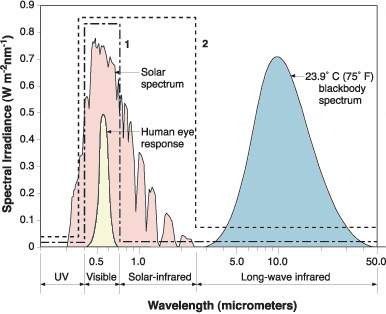| Heat Transfer Mechanisim
Heat Transfer Mechanisms and Glazing Properties Related
to Radiant Energy Transfer
Most window assemblies consist of glazing and frame components. Glazing
may be a single layer of glass (or plastic) or multiple layers with air
spaces in between. These multiple layer units, referred to as insulated
glazing units (IGU), include spacers around the edge and sometimes lower
conductance gases in the spaces between glazings. Coatings and tints affect
the performance of the glazing. The IGU then is placed within a frame
of aluminum, steel, wood, plastic, or some hybrid or composite material.
Some advanced curtain wall systems do not have frames in the conventional
sense.
Heat flows through a window assembly in three ways: conduction,
convection, and radiation. Conduction is heat traveling through a solid
material, the way a frying pan warms up. Convection is the transfer of
heat by the movement of gases or liquids, like warm air rising from a
candle flame. Radiation is the movement of heat energy through space without
relying on conduction through the air or by movement of the air, the way
you feel the heat of a fire.
Conduction through glass and solid frame materials and convection
within air spaces are discussed in the section on insulating value (U-factor).
Heat transfer through radiation deserves special attention because it
has been the source of much recent innovation in window energy performance.
Three things happen to solar radiation as it passes through a glazing
material. Some is transmitted, some is reflected, and the rest is absorbed.
Figure below shows the solar and thermal parts of the electromagnetic
spectrum that relate to windows. These include the ultraviolet, visible,
near-infrared, and far-infrared ranges.
 |
Glazing types vary in their transparency to different parts of the
visible spectrum. For example, a glass that appears to be tinted green
as you look through it toward the outside will transmit more sunlight
from the green portion of the visible spectrum, and absorb/reflect
more of the other colors. Similarly, a bronze-tinted glass will absorb/reflect
the blues and greens and transmit the warmer colors. Neutral gray
tints absorb/reflect most colors equally.
This same principle applies outside the visible spectrum. Most
glass is partially transparent to at least some ultraviolet radiation,
while plastics are commonly more opaque to ultraviolet. Glass is
opaque to far-infrared radiation but generally transparent to near-infrared.
Strategic utilization of these variations has made for some very
useful glazing products. The four basic properties of glazing that
affect radiant energy transfer--transmittance, reflectance, absorptance,
and emittance--are described below
|
|